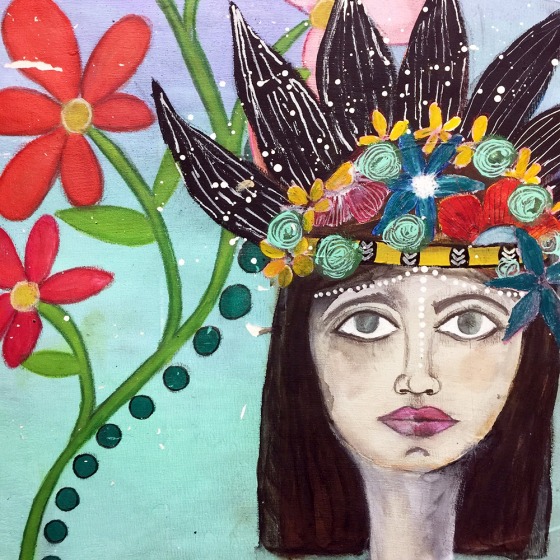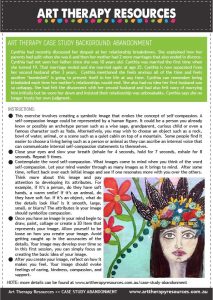THIS POST INCLUDES:
- Art Therapy and Abandonment
- About the Client
- Current Client Issues
- Art Therapy Exercise
- Client Insight and Outcomes
- Disclaimer
- FREE DOWNLOAD Art Therapy Exercise
ART THERAPY AND ABANDONMENT
Abandonment fears often stem from childhood where the individual experiences a significant loss of connection with a primary caregiver. This loss forms a substantial part of the individual’s foundation and can impact future relationships that would otherwise thrive on attachment.
CHILDREN
The most common experiences of loss that a child has with abandonment are from the death of a parent, adoption, or divorce. Abandonment can also occur when a child is living with an abusive parent. Although the parent is physically present, their abusive behaviour destroys any physical or emotional care that the child needs.
Many children do experience separations from parents and don’t develop abandonment issues. The response from children is always individual and in connection with the care the child receives before and after any traumatic events. If the child is cared for and encouraged to express any emotional pain when they lose a parent, this will impact the ability of them to develop positive relationships in the future.
As with all maladaptive behaviours, there is usually a perfect storm of circumstances that supports dysfunctional thinking and behaviours. When abandonment and the fear of abandonment is severe enough, the impact it has on an individual is significant.
ADULTS
Not all abandonment occurs in childhood as experiences can still impact an individual as they develop into adulthood. An example of adult abandonment is someone with a partner who has an affair. Even worse, multiple affairs can begin an ingrained set of beliefs in an individual that makes the abandonment feel severe enough to significantly alter the person’s worldview of safe relationships.
IDENTIFYING ABANDONMENT ISSUES
Below are a few issues that are common with those who are experiencing issues with abandonment:
- Anxiety
- Depression
- Self-blame and the reason why they have been abandoned
- Fear of future abandonment
- Sensitivity to criticism
- People pleasing to avoid abandonment
- Jealousy
- Repressed anger at previous abandonment
- Rejecting intimacy for fear of abandonment
- Seeking intimacy to validate worthiness
HOW TO HELP WITH ABANDONMENT ISSUES
Abandonment issues can have many layers of origin that your client will explore as therapy reveals deeper fears over time. In the meantime, emotional reactions can be overwhelming and disruptive to everyday living.
Some of the processes to work on for those who have abandonment issues include:
- Establish a feeling of security
- Reduce stress
- Reduce anxiety
- Identify and reduce self-blame
- Regulate emotions
- Develop awareness of emotional reactions
- Develop awareness of links to fear of abandonment
As fears from the past are explored, your client can learn to reduce their fear response in the present.
ABOUT THE CLIENT
- Name: Jenny
- Gender: Female
- Age: 38
- Summary of sessions to date: Cynthia has recently separated from her husband of 3 years. This was Cynthia’s second marriage. The first marriage had ended after 4 years of marriage. Cynthia has started attending art therapy sessions initially as part of a group and started attending individual sessions as she was struggling to cope with her recent breakup.
CURRENT CLIENT ISSUES
Cynthia had recently discussed her despair at her relationship breakdowns. She explained how her parents had split when she was 6 and then her mother had 2 more marriages that also ended in divorce. Cynthia had not seen her father since she was 10 years old. Cynthia was married for the first time when she turned 19. That marriage ended and she married again at age 25. Cynthia is now separated from her second husband after 3 years.
Cynthia mentioned she feels anxious all of the time and feels another ‘bombshell’ is going to present itself in her life at any time. Cynthia can remember being blindsided each time her mother’s relationships ended. She also had no idea her first husband was so unhappy. She had felt the disconnect with her second husband and had also felt wary of marrying him initially but he wore her down and insisted their relationship was unbreakable. Cynthia says she no longer trusts her own judgment.
ART THERAPY EXERCISE
This exercise is focused on self-compassion and is helpful for clients who are experiencing significant negative emotions that make them feel lesser and unworthy. This exercise involves creating a symbolic image that evokes the concept of self-compassion. A self-compassion image could be represented by a human figure. It could be a person you already know or possibly an archetype person such as a wise sage, grandparent, curious child or even a famous character such as Yoda.
Alternatively, you may wish to choose an object such as a rock, bowl of water, animal, or a scene such as a quiet cabin on top of a mountain. You may prefer to choose a different image from each type: person, object, scene. Some people find it easier to choose a living being such as a person or animal as they can ascribe an internal voice that can communicate internal self-compassion statements to themselves.
INSTRUCTIONS:
- This art therapy prompt is about creating a self-compassion image.
- Start by closing your eyes and slowing your breath (inhale for 4 seconds, hold for 7 seconds, exhale for 8 seconds. Repeat at least 5 times)
- Contemplate the word self-compassion and what it means to you. What images come to mind when you think of the word self-compassion. Let your mind wander through as many images as it brings to mind.
- After some time, reflect back over each initial image and see if one resonates more with you over the others.
Think more about this image and pay attention to developing its attributes. For example, if it’s a person, do they have soft hands, a warm smile? If it’s an animal, do they have soft fur. If it’s an object, what do the details look like? Is it smooth, large, small, or blurry?
The attributes in your image should symbolize compassion.- Once you have an image in your mind begin to draw, paint, collage or create a 3D item that represents your image. Allow yourself to be loose on how you create your image. Avoid getting caught up in the accuracies of the details. Your image may develop over time so in this first session, you can simply focus on creating the basic idea of your image.
- After you create your image, reflect on how it makes you feel. Your image should evoke feelings of caring, kindness, compassion, and support.
CLIENT INSIGHT AND OUTCOMES
Cynthia said the exercise helped alleviate some of the anxious feelings she was carrying. Cynthia could feel the tension leaving her body. Cynthia felt she was holding her tension as a protective barrier but also realised that protective barrier was also preventing her from healing. Doing the exercise helped Cynthia pay attention to her own feelings.
Cynthia also felt she had an ally on the image she had created. Her ally could help her through moments of tension and anxiety and remind her that self-compassion was beneficial for her.

DISCLAIMER
This case study represents a snapshot of the client’s progress in treatment. The exercise in this article could be used as written or as a guide for new and original tasks developed by the Art Therapist. Responsibility for treatment resides with the individual therapist who understands their clients specific needs. The art therapy exercise should not be viewed as a pre-defined directive on how to treat a client that presents with a specific range of problems.This art therapy exercise will help build a database of knowledge to draw upon when helping your client. Art Therapy is associated with psychotherapy techniques, however each therapist often approaches therapy with their own foundation of psychological interventions, whether it be psychotherapy, CBT, DBT or other methods.
FREE DOWNLOAD: Art Therapy Exercise
Download the FREE Art Therapy Exercise based on the above Case Study. The free download includes instructions for the art therapy exercise, along with an example of the art therapy exercise.

BUILD YOUR ART THERAPY REFERENCE MATERIALS:
Pin this image to your Pinterest board.

SHARE KNOWLEDGE & PASS IT ON:
If you’ve enjoyed this post, please share it on Facebook, Twitter, Pinterest. Thank you!
